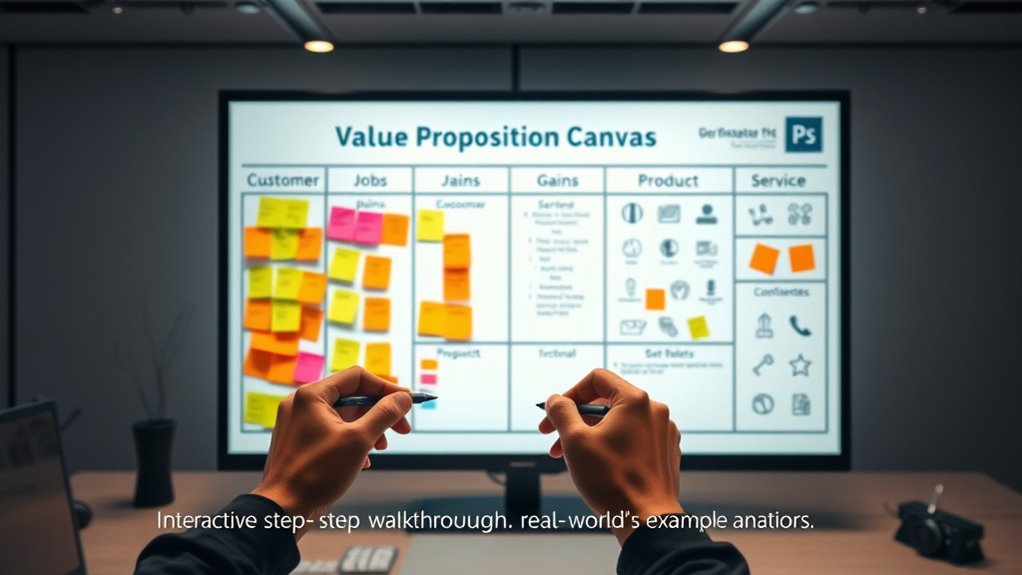To understand the Value Proposition Canvas step-by-step, start by identifying your target customer segments and their specific needs, pains, and gains. Map out their jobs and how your offerings can serve as pain relievers or gain creators. Then, align your products or services with these insights, testing and refining your approach through real-world feedback. If you keep exploring, you’ll discover how to craft compelling, customer-centered solutions that truly stand out.
Key Takeaways
- Break down customer segments by needs, pains, and gains to tailor your value proposition effectively.
- Map your products or services to address specific customer pains and create tangible gains.
- Use real-world examples to illustrate how to identify customer jobs, pains, and gains accurately.
- Continuously test and refine your value proposition based on customer feedback and market insights.
- Highlight your unique benefits and differentiators to stand out against competitors with clear messaging.
Understanding the Core Components of the Value Proposition Canvas

To truly grasp the Value Proposition Canvas, you need to understand its core components. The canvas centers around understanding your target market through effective market segmentation, which divides customers into distinct groups based on shared needs and behaviors. This segmentation helps you craft tailored value propositions that resonate with specific audiences. Additionally, competitive positioning plays a crucial role, as it helps you identify what sets your offering apart from competitors. By analyzing how your value aligns with customer needs and how it stacks up against alternatives, you can develop strategies that highlight your unique strengths. These core components ensure you deliver targeted, differentiated value, making your business more attractive to the right customers and increasing your chances of success. For example, selecting the right hair care products can significantly enhance customer satisfaction and brand loyalty by meeting specific hair needs.
Identifying Customer Segments and Their Needs

Understanding who your customers are and what they need is essential for creating a compelling value proposition. Start by analyzing customer demographics to identify key characteristics like age, gender, income, and location. This helps you understand the specific groups you’re targeting. Market segmentation allows you to divide your broader audience into smaller, more manageable segments based on shared needs, behaviors, or preferences. By pinpointing these segments, you can tailor your offerings to meet their unique needs effectively. Focus on uncovering common pain points, desires, and motivations within each group. This targeted approach ensures your value proposition resonates with the right customers, increasing engagement and satisfaction. Clear segmentation ultimately guides your messaging and product development efforts, making your value proposition more compelling. Additionally, understanding Well-Being Tips can help you align your offerings with the holistic needs of your customers, fostering stronger connections.
Mapping Customer Jobs, Pains, and Gains

Mapping customer jobs, pains, and gains involves identifying what your customers are trying to accomplish, the obstacles they face, and the benefits they seek. This process deepens customer empathy and helps you understand their real motivations. By analyzing customer jobs, you see the tasks they want to complete, whether functional, social, or emotional. Pains highlight frustrations or obstacles that hinder those jobs, while gains reveal the positive outcomes they desire. Effective mapping supports better market segmentation, ensuring you target the right customer groups with tailored solutions. This step clarifies customer priorities and challenges, enabling you to develop offerings that truly resonate. Understanding herbal properties can also provide additional insights into how products meet customer needs more effectively. Ultimately, it bridges the gap between customer needs and your value proposition, making your solutions more relevant and impactful.
Designing Value Map: Products and Services, Pain Relievers, and Gain Creators

Designing the value map involves identifying specific products and services that directly address your customers’ needs, pains, and gains. To do this effectively, you should analyze your offerings through targeted marketing strategies, ensuring they align with customer priorities. Consider how your products can serve as pain relievers, alleviating frustrations or obstacles your customers face. Simultaneously, identify gain creators that amplify benefits or add extra value. Conduct a competitive analysis to understand what competitors offer and uncover opportunities to differentiate your products and services. This process helps you craft a clear, compelling value map that resonates with customers, making it easier to communicate your value proposition and stand out in the market. Incorporating digital resources such as collaboration apps and industry insights can further enhance your understanding of customer needs and preferences.
Aligning Customer Profile With Value Map

Aligning your customer profile with your value map guarantees that your offerings truly meet the needs, pains, and gains you’ve identified. To do this effectively, you need strong customer empathy, which helps you understand your target audience’s perspectives. By carefully analyzing your market segmentation, you ensure your value propositions are tailored to specific customer segments, rather than a one-size-fits-all approach. This alignment ensures that each pain reliever and gain creator directly addresses the real issues and desires of your customers. When your customer profile and value map are in sync, you build a cohesive strategy that resonates with your audience, enhances engagement, and increases the likelihood of delivering value that truly matters. This step is fundamental for creating a compelling and relevant value proposition. Additionally, understanding privacy policies and cookie preferences can help you better tailor your offerings to meet customer expectations for data privacy and transparency.
Testing and Refining Your Value Proposition

How can you guarantee your value proposition truly resonates with your customers? The key is ongoing customer feedback and iterative testing. Share your value proposition with a small group of target customers, and listen carefully to their responses. Use their feedback to identify gaps, misunderstandings, or areas needing improvement. Then, refine your messaging accordingly. Incorporate customer insights to better understand their preferences and expectations. Repeat this cycle—test, gather customer insights, and adjust—until your value proposition clearly communicates the value you offer. This process helps you discover what truly appeals to your audience and ensures your messaging remains relevant. Remember, refining isn’t a one-time task; it’s a continuous effort that sharpens your value proposition over time, increasing your chances of connecting deeply with your customers and meeting their needs effectively.
Applying the Canvas to Real-World Business Scenarios

Have you ever wondered how to turn a theoretical framework like the Value Proposition Canvas into practical insights for your business? Applying the canvas to real-world scenarios helps you understand how to boost customer loyalty and stand out from competitors. By mapping out customer jobs, pains, and gains, you can identify unique value propositions that resonate deeply. For example, a company could refine its messaging to emphasize benefits that foster long-term relationships, increasing customer retention. It also reveals areas where your offering can be differentiated, giving you a competitive edge. Using the Canvas in actual business situations allows you to align your product or service more closely with customer needs, leading to stronger loyalty and clear market positioning. Incorporating diverse genres from popular animated movies can inspire innovative ways to present your value propositions and appeal to a broader audience. This practical application turns theory into tangible growth strategies.
Tips for Effective Use and Common Pitfalls to Avoid

To make the most of the Value Proposition Canvas, it’s essential to follow some key tips and be aware of common pitfalls. Focus on deeply understanding your customers’ needs to boost customer engagement and create genuine value. Avoid making assumptions; instead, validate your insights through customer feedback. Be specific and clear when defining customer jobs, pains, and gains to ensure your value proposition resonates. Don’t overlook the importance of differentiating your brand; use the Canvas to highlight unique benefits that set you apart. A common pitfall is neglecting alignment between your value proposition and actual customer needs, which can weaken engagement and brand credibility. Regularly update and refine your Canvas based on real-world insights to maximize its effectiveness and sustain competitive advantage. Additionally, leveraging insights from reviews of educational toys can help tailor your offerings to better meet customer expectations and improve overall value.
Frequently Asked Questions
How Can I Prioritize Customer Needs Within the Value Proposition Canvas?
To prioritize customer needs effectively, you should use prioritization techniques like Kano or MoSCoW to identify what matters most. Segment your customers to understand their specific needs better. Focus on high-impact needs that align with your business goals, and validate these through feedback. This targeted approach guarantees you address the most critical needs of your customer segments, creating a compelling value proposition that resonates.
What Tools Complement the Value Proposition Canvas for Comprehensive Analysis?
Like a trusty compass in uncharted waters, tools like customer segmentation and competitive analysis complement your analysis, offering clarity. These help you understand your audience better and identify gaps or strengths relative to rivals. Integrate these with your value proposition canvas to get a holistic view. This combo ensures you’re addressing real customer needs while staying ahead in the market, avoiding the blind spots of a lone navigation tool.
How Do Cultural Differences Impact the Application of the Canvas?
You should consider how cultural nuances influence your approach, as they affect customer needs and perceptions. In cross-cultural adaptation, you must tailor your value propositions to resonate with diverse audiences, respecting their unique values and expectations. By understanding these cultural differences, you can create more effective, personalized messages that connect deeply with varied customer segments. This enhances engagement and boosts your success in global markets.
Can the Canvas Be Adapted for B2B and B2C Markets?
You can definitely adapt the canvas for both B2B and B2C markets by focusing on market segmentation and brand positioning. For B2B, emphasize the company’s needs, decision-makers, and long-term value. In B2C, target individual consumer desires and emotional triggers. Adjust your value propositions accordingly, ensuring your messaging resonates with each audience’s unique preferences and pain points, strengthening your overall market strategy.
What Are Common Mistakes to Avoid During Customer Profiling?
You might think you know your customers, but avoid falling into the trap of customer bias—assuming you understand them without proper research. Don’t fall for segmentation pitfalls by rushing into broad categories or ignoring subtle differences. Overgeneralizing can lead to misguided strategies. Keep your profiling precise, challenge assumptions regularly, and gather real insights. This way, you’ll truly connect with your audience instead of wasting time on false stereotypes.
Conclusion
Remember, the devil’s in the details, so take the time to thoroughly map out your customer and value propositions. By aligning these elements, you’ll create solutions that truly resonate. Keep testing and refining—your perfect fit may be just one iteration away. As the saying goes, “A journey of a thousand miles begins with a single step,” so start small, stay focused, and watch your value proposition grow stronger with each step.









